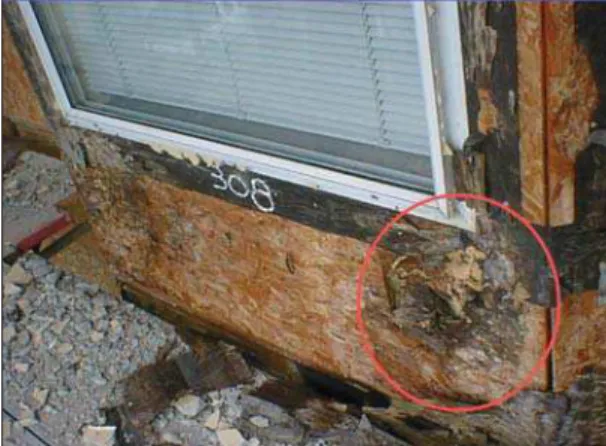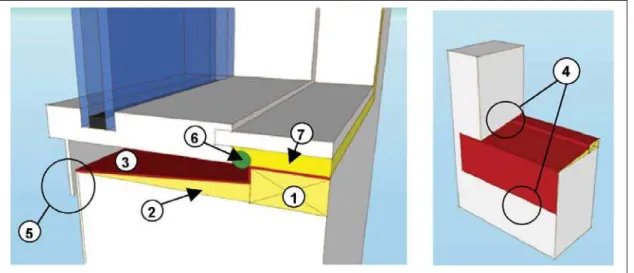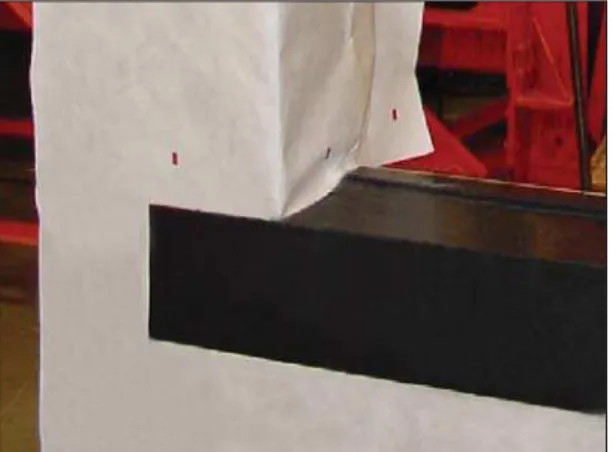Publisher’s version / Version de l'éditeur:
Construction Technology Update, 2011-04-01
READ THESE TERMS AND CONDITIONS CAREFULLY BEFORE USING THIS WEBSITE. https://nrc-publications.canada.ca/eng/copyright
Vous avez des questions? Nous pouvons vous aider. Pour communiquer directement avec un auteur, consultez la
première page de la revue dans laquelle son article a été publié afin de trouver ses coordonnées. Si vous n’arrivez pas à les repérer, communiquez avec nous à PublicationsArchive-ArchivesPublications@nrc-cnrc.gc.ca.
Questions? Contact the NRC Publications Archive team at
PublicationsArchive-ArchivesPublications@nrc-cnrc.gc.ca. If you wish to email the authors directly, please see the first page of the publication for their contact information.
NRC Publications Archive
Archives des publications du CNRC
For the publisher’s version, please access the DOI link below./ Pour consulter la version de l’éditeur, utilisez le lien DOI ci-dessous.
https://doi.org/10.4224/20330799
Access and use of this website and the material on it are subject to the Terms and Conditions set forth at
Window sill details for effective drainage of water
Lacasse, M. A.; Armstrong, M. M.
https://publications-cnrc.canada.ca/fra/droits
L’accès à ce site Web et l’utilisation de son contenu sont assujettis aux conditions présentées dans le site LISEZ CES CONDITIONS ATTENTIVEMENT AVANT D’UTILISER CE SITE WEB.
NRC Publications Record / Notice d'Archives des publications de CNRC:
https://nrc-publications.canada.ca/eng/view/object/?id=ecf7a954-47dd-4703-a516-86aedee41132 https://publications-cnrc.canada.ca/fra/voir/objet/?id=ecf7a954-47dd-4703-a516-86aedee41132Inadequate detailing practices and improper installation of windows have led to numer-ous premature and costly building envelope failures caused by water entry. Because the watertightness of the window itself cannot always be assured over its life, measures should be taken to avert the damaging effects of inadvertent water entry. Water entry can cause damage to interior finishes and in the case of wood-frame construction, may lead to wood rot or the formation of mould in the wall assembly (Figure 1).
There are a number of different
approaches to window installation depend-ing on the type of window (box or with mounting flange) and whether installation precedes or follows that of the sheathing membrane. But which methods are best to mitigate the effects of water entry and cope with the expected loss in watertightness over the life of an installation? Which installation features are most likely to ensure long-term performance?
This Update focuses on sill details for effective drainage of inadvertent water entry at the wall-window interface or entry from a defective window. These details are intended for either new window installation or the replacement of existing windows.
NRC-IRC Research on Window Installation Details
The NRC Institute for Research in Construction (NRC-IRC) undertook a research project to investigate the effective-ness of various wall-window interface details for managing rainwater. The intent was to assess the robustness of specified window installations by considering what occurs when windows leak, when jointing products at the window interface fail, or when the installation has reduced airtightness.
By M.A. Lacasse and M.M. Armstrong
Satisfactory window performance demands a good product and proper
installation. This Update presents results from a recent study of sill
installation details for the effective drainage of inadvertent water entry at
the wall-window interface.
Window Sill Details for Effective
Drainage of Water
Construction Technology Update
No. 76
The laboratory testing was designed to represent residential window installation practice. Testing was conducted on wall-window interface details incorporating vinyl windows with mounting flanges and variations in approaches to their installation. The wall-window assemblies (see Figure 2) were subjected to watertightness performance tests that mimic significant wind-driven rain loads. These test loads match those of significant rainfall events of 5, 15 or 30 minutes duration that might occur every 10 to 30 years.
Response of Wall-Window Interface to Wind-Driven Rain
Water may enter at the window because of deficiencies in the window components, either inherent or after the window has “aged.” It may also enter because of incor-rect window installation. When rain water is driven to the window, the risk of water entry at any deficiency increases, given that water may enter small openings due to the actions of gravity, capillary forces, or wind. Water entering a defective window or along the perimeter interface between the window and cladding may find its way into the wall assembly, but ultimately some water drains downwards and collects at the sill (Figure 3).
2
Figure 2. (a) Sample wall-window test assembly; (b) Diagram of wall-window assembly showing locations of wall-window interface details
head
jambs
sill
Figure 3.(a) Vertical section of a window with mounting flanges illustrating water entry at the base of the window and collection at sill; (b) Water accumulating at the sill must be drained
ΔP (wind)
Water collecting at the sill must be managed as it may eventually seep into the wall assembly, causing damage to moisture-sensitive components. Stagnant water is also to be avoided as it may lead to the growth of mould.
Installation Details for Managing Rainwater Entry
Results derived from the laboratory testing of different window installation designs showed that the window should be installed with a sill flashing “system.” Key elements of a sill flashing system for a window with a mounting flange that provides adequate protection to inadvertent water entry are provided in Figure 4 and include: • Back dam (1)
• Sloped sill (2)
• Sill flashing membrane wrapping up the jambs and over the sheathing membrane at the sill (3)
• Proper lapping of flashing layers and the sheathing membrane (4)
• Drainage gap behind the window flange (5)
• Backer rod and sealant to provide continuity of the air barrier (6)
• Insulation to the interior side of the sill, leaving the drainage path unobstructed (7)
The back dam, as the name suggests, provides a stop to water being driven into the wall assembly at the innermost part of the window opening; the sloped sill (the unprotected sloped sill and back dam are also shown in Figure 5) ensures that any water entry at the window sill is simply directed to a gap between the window frame and the edge of the sill where it drains to the exterior simply by the action of gravity. To promote adequate drainage, the slope at the sill should be at least 1/15 the depth of the window sill (i.e. ¼-in. rise over 3¾ in. depth).
Figure 4. Vertical section of window showing key elements for adequate management of inadvertent water entry at the window sill
A sill flashing membrane is installed to protect the sloped sill; this same protection is extended up the jambs (Figure 6). Proper lapping of the flashing layers over the sheathing membrane at the sill, but beneath the sheathing at the jambs, helps ensure proper drainage and averts water entry behind the sheathing membrane (Figure 7).
If the window has an installation flange, the flange must not come into direct con-tact with the sill, as this has been shown to retard or prevent the drainage of water present at the sill. A small gap (2-3 mm) between the flange and sill edge is all that is necessary to provide drainage at this location (see Figure 4). For example, this can be accomplished through the use of cap nails installed behind the flange at the sill.
Ensuring continuity of the air barrier is a crucial element in the installation of the window. This is achieved by incorporating a sealant and backer rod at the interior perimeter seal of the window assembly (Figure 8). The seal must be made to the interior air barrier element (e.g., a polyeth-ylene vapour barrier) to ensure continuity.
The final element in the installation is insulation. Insulation should be placed at the head and jambs and, as shown in Figure 4, at the sill as well. Note that the sloped sill should remain unobstructed so as to allow for proper drainage.
Selection of Components and their Assembly
Regarding the selection of components, sill pan products can be obtained as flexible membranes, preformed flexible or rigid plastic or metal elements. Some of the flexi-ble membranes are the self-adhering type; this can help ease the installation process. Although there are several types of sill pan products on the market, results from test-ing, although not focused on evaluating the products as such, did not reveal any advan-tages to one type over the other. However, it was revealed that self-sealing products, such as self-adhered flexible membrane products, help reduce the risk of water entry at fastener locations.
4
Figure 6.Pan flashing (black, self-adhered membrane) extends up the jambs
Figure 7.Proper lapping of sheathing membrane and self-adhered flashing (shingle fashion)
Figure 8.Sealing the window frame to the air barrier at the interior side
When selecting components that help ensure air and water tightness – such as gaskets, sealants, and spray-in-place foams – thought needs to be given to whether the combination of components that come into contact with one another will remain intact over the life of the assembly. For products that rely on adhesion to provide air and water tightness of the assembly, the issue of compatibility between products should be considered. Compatible products will likely remain attached whereas incompatible products may lose adhesion prematurely. Gaskets are typically preformed closed-cell foam or rubber products that provide a seal by being compressed into a joint; the desired seal is achieved by selecting a gas-ket size slightly larger than the expected joint width. Since exposure to heat causes such products to lose their elasticity or resilience over time and thus their ability to provide a seal, gaskets need to be replaced periodically.
Of particular importance to ensuring a successful sill pan flashing is the sequence of installation of the different components. This cannot be overemphasized as without it, it is unlikely that sheathing membranes and flashing will be properly lapped to ensure positive drainage. This proper lapping (shingle fashion) is shown in Figure 7. Implications
Results from these NRC-IRC tests indicate that window installation designs that do not permit drainage from the sill are vulnerable to excessive water retention when exposed to extreme rainfall events. Window instal-lation details that provide a proper route for drainage, and include the related installation features as described in this Update, are adequate to manage even the most significant rainfall events occurring in North America.
Summary
This Update focused on providing key window installation details that ensure effective drainage of inadvertent water entry at the wall-window interface. The prescribed practice was based on results of NRC-IRC laboratory watertightness testing on different types of windows. A sill pan flashing system that incorporates a back dam, sloped sill, protective membrane for the rough opening and takes into considera-tion the proper sequence of installaconsidera-tion of components, are all key features of an ade-quate system. Window installation details that provide a proper route for drainage, as described in this Update, are adequate for managing even the most significant rainfall events occurring in North America.
Other issues in window installation
There are a number of other important issues to consider when installing windows, beyond what has been covered in this Update. These will be explored in three future Updates:
• Airtightness: How the degree of air-tightness, and the location of the plane of airtightness of the wall-window interface, affect water entry.
• Condensation risks: To what degree do wall-window drainage details and airtightness affect the risk to conden-sation on windows?
• Wind-driven rain loads: How wind-driven rain loads vary across Canada, why knowledge of these loads is important to window installation design and how this affects installa-tion details.
Bibliography
Design of Durable Joints between Windows and Walls, Canada Mortgage and Housing
Corporation, Ottawa, 2002.
Building Envelope Guide for Houses: Part 9 Residential Construction, Homeowner
Protection Office, BC Ministry of Housing, Burnaby, BC, 2010.
Water Penetration Resistance of Windows – Study of Codes, Standards, Testing and Certification, RDH Building Engineering
Limited, for Canada Mortgage and Housing Corporation, Ottawa, 2002.
Water Penetration Resistance of Windows – Study of Manufacturing, Building Design, Installation and Maintenance Factors,
RDH Building Engineering Limited, for Canada Mortgage and Housing Corporation, Ottawa, 2003.
Lacasse, M.A.; Manning, M.M.; Ganapathy, G.; Rousseau, M.Z.; Cornick, S.M.; Bibee, D.; Shuler, D.; Hoffee, A., Assessing the
effectiveness of wall-window interface details to manage rainwater – selected results from window installation to a wall sheathed in extruded polystyrene,
Journal of ASTM International Vol. 6(9), 43 p. NRCC 50031, 2009.
Lacasse, M.A.; Rousseau, M.Z.; Cornick, S.M.; Manning, M.M.; Nicholls, M.; Nunes, S.C., Evaluating the effectiveness of
wall-window interface details to manage rainwater Phase 1 – watertightness, air leakage and rainwater management of CMHC specified assemblies, Client Report,
B-1229.1, National Research Council Institute for Research in Construction, Ottawa, 254 p., 2008.
Lacasse, M.A.; Manning, M.M.;
Rousseau, M.Z.; Cornick, S.M.; Plescia, S.; Nicholls, M.; Nunes, S.C., Results on
assessing the effectiveness of wall-window interface details to manage rainwater,
11thCanadian Building Science and
Technology Conference, Banff, Alberta, pp. 1-14, NRCC 49201, March 2007. Web site:
http://www.nrc-cnrc.gc.ca/eng/projects/ irc/manage-rainwater.html
Dr. M. A. Lacasse is a Senior Research Officer in
the Building Envelope and Structure program at the National Research Council’s Institute for Research in Construction.
Ms. M.M. Armstrong is a Research Council
Officer with the same program.
“Construction Technology Updates” is a series of technical articles containing practical information distilled from recent construction research.
For more information, contact Institute for Research in Construction, National Research Council of Canada, Ottawa K1A 0R6.
Telephone: (613) 993-2607; Facsimile: (613) 952-7673; Internet: http://www.nrc-cnrc.gc.ca/irc
© 2011
National Research Council of Canada March 2011
ISSN 1206-1220
Project partners
Canada Mortgage and Housing Corporation DuPont Weatherization Systems
Building Diagnostic Technology Inc.,



